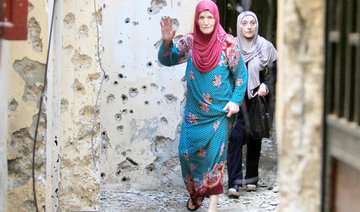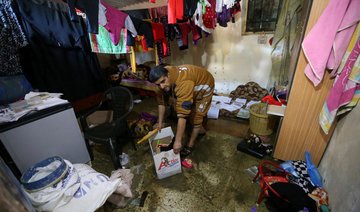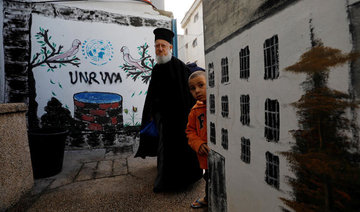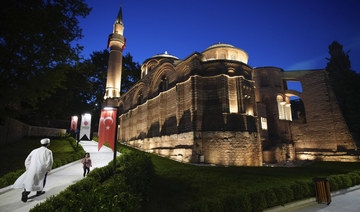SHATI REFUGEE CAMP, Gaza: Mahmoud Al-Qouqa can not imagine life without the three sacks of flour, cooking oil and other staples he receives from the UN every three months.
Living with 25 relatives in a crowded home in this teeming Gaza Strip slum, the meager rations provided by UNRWA, the UN agency for Palestinian refugee families, are the last thing keeping his family afloat in the territory hard hit by years of poverty and conflict. But that could be in danger as the US, UNRWA’s biggest donor, threatens to curtail funding.
“It will be like a disaster and no one can predict what the reaction will be,” Al-Qouqa said.
Across the Middle East, millions of people who depend on UNRWA are bracing for the worst. The expected cut could also add instability to struggling host countries already coping with spillover from other regional crises.
UNRWA was established in the wake of the 1948 Mideast war surrounding Israel’s creation. An estimated 700,000 Palestinians fled or were forced from their homes in the fighting.
In the absence of a solution for these refugees, the UN General Assembly has repeatedly renewed UNRWA’s mandate, the original refugee camps have turned into concrete slums and more than 5 million refugees and their descendants now rely on the agency for services including education, health care and food. The largest populations are in Gaza, the West Bank, Jordan and Lebanon.
Seen by the Palestinians and most of the international community as providing a valuable safety net, UNRWA is viewed far differently by Israel.
Prime Minister Benjamin Netanyahu accuses the agency of perpetuating the conflict by helping promote an unrealistic dream that these people have the “right of return” to long-lost properties in what is now Israel.
“UNRWA is part of the problem, not part of the solution,” he told foreign journalists last week. Noting that the Palestinians are the only group served by a specific refugee agency, he said UNRWA should be abolished and its responsibilities taken over by the main UN refugee agency.
Some in Israel have even tougher criticism, accusing UNRWA of teaching hatred of Israel in its classrooms and tolerating or assisting Hamas militants in Gaza.
Blaming the Palestinians for lack of progress in Mideast peace efforts, President Donald Trump has threatened to cut American assistance to the Palestinians. UNRWA would be the first to be affected.
The US provides about $355 million a year to UNRWA, roughly one-third of its budget.
US officials in Washington said this week the administration is preparing to withhold tens of millions of dollars from the year’s first contribution, cutting a planned $125 million installment by half or perhaps entirely. The decision could come as early as Tuesday.
Matthias Schmale, UNRWA’s director in Gaza, said Washington has not informed the agency of any changes. However, “we are worried because of the statements ... in the media and the fact that the money hasn’t arrived yet,” he said.
Schmale dismissed the Israeli criticisms, saying that individuals who spread incitement or aid militants are isolated cases and promptly punished. And he said Netanyahu’s criticism should be directed at the UN General Assembly, which sets UNRWA’s mandate, not the agency itself.
Any cut in US aid could ripple across the region with potentially unintended consequences.
Gaza may be the most challenging of all of UNRWA’s operating areas. Two-thirds of Gaza’s 2 million people qualify for services, and its role is amplified given the poor state of the economy, which has been hit hard by an Israeli-Egyptian blockade since the Hamas militant group seized power over a decade ago. Unemployment is 43 percent and the poverty rate is 38 percent, according to the official Palestinian statistics office.
“Nowhere else are we the biggest service provider for the population of the entire territory,” Schmale said. He said UNRWA provides food assistance to 1 million Gazans, calling it “an expression of collective shame for the international community.”
With more than 12,500 teachers, nurses and other staff, UNRWA is Gaza’s largest non-governmental employer. It is also involved in postwar reconstruction projects.
The dire situation in Gaza is evident inside Al-Qouqa’s home, which is so cramped the family has made sleeping spaces with wood boards and fabric. Two male family members are unemployed. Two others are Hamas civil servants and get paid only intermittently by the cash-strapped movement.
At 72, Al-Qouqa is worried about his grandchildren. “If UNRWA provides them with bread, they can remain patient. But if it was cut, what will they become? They will become thieves, criminals and a burden on society,” he said. Many believe Hamas, which administers schools and social services in Gaza, will step in to fill the void.
Jordan, a crucial ally in the US-led battle against militants, is home to the largest number of Palestinian refugees and their descendants — with nearly 2.2 million people eligible for UNRWA services. This has turned the UN agency into a major contributor to social welfare services in the country, which also hosts hundreds of thousands of Syrians displaced by war.
US aid cuts could heighten the threat of instability in Jordan, which is grappling with a worsening economy hurt by the spillover from conflict in neighboring Syria and Iraq. More than one-third of Jordan’s young people are without jobs, turning them into potential targets for recruitment by extremists.
Most of the Palestinians eligible for UNRWA services in Jordan hold Jordanian citizenship, and some argue that this has ended their refugee status. But most maintain that UNRWA services are vital to propping up an important ally.
UNRWA’s services are also vital in Lebanon, where Palestinians are prohibited from working in skilled professions and owning property.
Lebanon is the least-welcoming Arab country to Palestinian refugees, because it does not want Palestinians to settle and because it does not want the refugees to upset the country’s delicate sectarian balance. Camps in several cities are ringed by concrete barriers and Lebanese security forces use checkpoints to control who enters and leaves. A recent census found 175,000 Palestinian refugees or their descendants living in the country.
The civil war in Syria has made many Palestinians refugees twice over. Some 32,000 Palestinians who were living in Syria fled to Lebanon, according to UNRWA. In Syria, Palestinians enjoyed the right to own property and to work in all professions. They are not entitled to the same in Lebanon.
Balkees Hameed, 33, arrived in 2013 with her husband, two children and in-laws from Damascus, where their apartment was damaged by rocket fire. The family depends on UNRWA assistance to rent a one-bedroom apartment in a ramshackle building in Bourj Al-Barajneh, a Beirut camp. Her husband wipes tables at a restaurant outside the camp. Hameed, like all Palestinians, was painfully aware of the rumors coming out of Washington.
“We are already defeated and now they want to oppress us some more?” she asked.
While more than 5 million Syrian refugees worldwide are entitled to assistance from the UN’s general refugee relief agency, Palestinians are barred from it under the logic that UNRWA serves them. But UNRWA in Lebanon is chronically underfunded, and the wave of Palestinians arriving from Syria has strained its finances even further.
“What UNRWA provides is not even a quarter of what a Palestinian refugee needs,” said Ramy Mansour, 34, who fled to Lebanon from the Yarmouk refugee camp in Damascus in 2013. “Take everything and return us to our homes. We don’t want any assistance or anything, just return us to our country.”
Across the Mideast, Palestinians brace for Trump aid cuts
Across the Mideast, Palestinians brace for Trump aid cuts
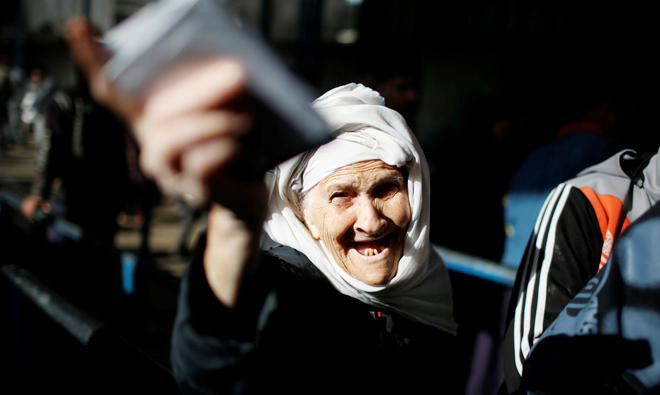
Moroccans in pro-Palestinian march rally against Israel ties

- Rabat has officially denounced what it said were “flagrant violations of the provisions of international law” by Israel in its war against Hamas, but has not given any indication that normalization with Israel would be undone
- Israel has killed at least 35,456 people in Gaza, also mostly civilians, according to data provided by the Hamas-run territory’s health ministry
CASABLANCA, Morocco: Thousands of Moroccans demonstrated Sunday in Casablanca in support of the Palestinian people and against ties with Israel, an AFP journalist said, more than seven months into the Gaza war.
Protesters in Morocco’s commercial capital chanted “Freedom for Palestine,” “If we don’t speak out, who will?” and “No to normalization,” and many wore keffiyeh scarves or waved Palestinian flags.
The North African kingdom established diplomatic ties with Israel in late 2020 under the US-brokered Abraham Accords which saw similar moves by the United Arab Emirates and Bahrain.
Under the deal, the United States recognized Morocco’s claim to sovereignty over the disputed territory of Western Sahara.
Since the Israel-Hamas war in the Gaza Strip began on October 7, large-scale demonstrations in Morocco have called for the abrogation of the normalization accord.
On Sunday, the demonstrators marched through central Casablanca in a protest called by a grouping of leftist parties and Islamist movements.
“I cannot remain indifferent and silent in the face of what is happening to the Palestinians who are being killed on a daily basis,” demonstrator Zahra Bensoukar, 43, told AFP.
Idriss Amer, 48, said he was protesting “in solidarity with the Palestinian people, against the Zionist massacre in Gaza and against normalization” of ties with Israel.
Rabat has officially denounced what it said were “flagrant violations of the provisions of international law” by Israel in its war against Hamas, but has not given any indication that normalization with Israel would be undone.
The Gaza war broke out after Hamas on October 7 launched an unprecedented attack on Israel which resulted in the deaths of more than 1,170 people, mostly civilians, according to an AFP tally based on Israeli official figures.
Israel’s retaliatory offensive has killed at least 35,456 people in Gaza, also mostly civilians, according to data provided by the Hamas-run territory’s health ministry.
Hamas also took about 250 hostages on October 7, of whom 124 remain held in Gaza including 37 the Israeli military says are dead.
What do we know so far about the mysterious crash of the helicopter carrying Iran’s president?

- Initially, Interior Minister Ahmad Vahidi said the helicopter “was forced to make a hard landing due to the bad weather and fog”
BEIRUT: The apparent crash of a helicopter carrying Iran’s president and foreign minister on Sunday sent shock waves around the region.
Details remained scant in the hours after the incident, and it was unclear if Iranian President Ebrahim Raisi and the other officials had survived.
Here’s what we know so far.
WHO WAS ON BOARD THE HELICOPTER AND WHERE WERE THEY GOING?
The helicopter was carrying Iranian President Ebrahim Raisi, the country’s Foreign Minister Hossein Amirabdollahian, the governor of Iran’s East Azerbaijan province and other officials and bodyguards, according to the state-run IRNA news agency. Raisi was returning from a trip to Iran’s border with Azerbaijan earlier Sunday to inaugurate a dam with Azerbaijan’s President Ilham Aliyev, the news agency said.
WHERE AND HOW DID THE HELICOPTER GO DOWN?
The helicopter apparently crashed or made an emergency landing in the Dizmar forest between the cities of Varzaqan and Jolfa in Iran’s East Azerbaijan province, near its border with Azerbaijan, under circumstances that remain unclear. Initially, Interior Minister Ahmad Vahidi said the helicopter “was forced to make a hard landing due to the bad weather and fog.”
WHAT IS THE STATUS OF THE SEARCH OPERATIONS?
Iranian officials have said the mountainous, forested terrain and heavy fog impeded search-and-rescue operations. The president of the Iranian Red Crescent Society, Pir-Hossein Koulivand, said 40 search teams were on the ground in the area despite “challenging weather conditions.” The search is being done by teams on the ground, as “the weather conditions have made it impossible to conduct aerial searches” via drones, Koulivand said, according to IRNA.
IF RAISI DIED IN THE CRASH, HOW MIGHT THIS IMPACT IRAN?
Raisi is seen as a protégé to Iran’s supreme leader Ayatollah Ali Khamenei and a potential successor for his position within the country’s Shiite theocracy. Under the Iranian constitution, if he died, the country’s first vice president, Mohammad Mokhber, would become president. Khamenei has publicly assured Iranians that there would be “no disruption to the operations of the country” as a result of the crash.
WHAT HAS THE INTERNATIONAL REACTION BEEN?
Countries including Russia, Iraq and Qatar have made formal statements of concern about Raisi’s fate and offered to assist in the search operations.
Azerbaijani President Aliyev said he was “deeply concerned” to hear of the incident, and affirmed that Azerbaijan was ready to provide any support necessary. Relations between the two countries have been chilly due to Azerbaijan’s diplomatic relations with Israel, Iran’s regional arch-enemy.
There was no immediate official reaction from Israel. Last month, following an Israeli strike on an Iranian consular building in Damascus that killed two Iranian generals, Tehran launched hundreds of missiles and drones at Israel. They were mostly shot down and tensions have apparently since subsided.
EU Red Sea mission says it defended 120 ships from Houthi attacks

- Human rights activist raps cases of prisoner fatalities as a result of torture in militia’s captivity
AL-MUKALLA, Yemen: The EU mission in the Red Sea, known as EUNAVFOR Aspides, said on Sunday that it had protected over 100 ships while sailing the critical trade channel and shot down more than a dozen Houthi missiles and drones in the last three months.
In a post on X marking three months since the start of its operation, the EU mission, which is now made up of five naval units and 1,000 personnel from 19 contributing nations, said that its forces had destroyed 12 drones, one drone boat, and four ballistic missiles fired by the Houthis from areas under their control in Yemen, as well as provided protection to 120 commercial ships since February.
“Great day for Freedom of Navigation, as 3 months have passed since the launch of ASPIDES. Three months of multiple challenges and great achievements. ASPIDES continues its mission in full compliance with international law, to ensure maritime security and seaborne trade,” EUNAVFOR Aspides said.
On Feb. 19, the EU announced the commencement of EUNAVFOR Aspides, a military operation in the Red Sea to defend international marine traffic against Houthi attacks.
At the same time, the Philippines Department of Migrant Workers said on Sunday that 23 of its citizens who were aboard the oil ship assaulted by Houthi militia in the Red Sea on Saturday were safe.
“The DMW is closely coordinating with international maritime authorities, shipping companies, and local manning agencies on the status of ships with Filipino seafarers traversing high-risk areas and war-like zones in the Red Sea and the Gulf of Aden,” the DMW said in a statement carried by the official Philippine News Agency.
For seven months, the Houthis have launched hundreds of ballistic missiles, drones, and drone boats against commercial and navy ships along international commerce lanes off Yemen, including the Red Sea.
The Houthis claim that their strikes are intended to push Israel to cease the war in Gaza and allow humanitarian supplies into the Palestinian territory.
Three civilian sailors, including two Filipinos, were killed in March after the Houthis launched a missile at their ship in the Red Sea.
Many international shipping companies directed their ships to avoid the Red Sea and other passages off Yemen, opting for longer and more costly routes through Africa.
Meanwhile, Yemen human rights activists have said that a man held by the Houthis during the last seven years died as a result of abuse in Houthi imprisonment, making him the latest victim of torture within Houthis detention facilities.
On Saturday, the Houthis told the family of Najeed Hassan Farea in Taiz through the Yemen Red Crescent that their son had died in their custody, but they did not explain how.
The Houthis abducted Farea in February 2017 after storming his village and home in the Al-Taziya district, preventing him from contacting his family and denying them information about where he was being detained.
Eshraq Al-Maqtari, a human rights activist in Taiz who reached Farea’s family, told Arab News that the Houthis cruelly tortured the man and that his family was stunned to hear of his death after years of information blackout since his detention.
“He was denied the right to communicate, to know his fate, and the right to healthcare, which appears to have caused his death,” she said, adding that since the start of the year, there have been three verified cases of prisoner fatalities as a result of torture in Houthi captivity.
10 years on, thousands forgotten in Syria desert camp

- Rukban camp was established in 2014 as desperate people fled Daesh and Syrian regime bombardment in hopes of crossing into Jordan
BEIRUT: In a no-man’s land on Syria’s border with Iraq and Jordan, thousands are stranded in an isolated camp, unable to return home after fleeing the regime and militants years ago.
When police defector Khaled arrived at Rukban, he had hoped to be back home within weeks — but eight years on, he is still stuck in the remote desert camp, sealed off from the rest of the country.
Damascus rarely lets aid in and neighboring countries have closed their borders to the area, which is protected from Syrian forces by a nearby US-led coalition base’s de-confliction zone.
“We are trapped between three countries,” said Khaled, 50, who only gave his first name due to security concerns.
“We can’t leave for (other areas of) Syria because we are wanted by the regime, and we can’t flee to Jordan or Iraq” because the borders are sealed, he added.
The camp was established in 2014, at the height of Syria’s ongoing war, as desperate people fled Daesh and regime bombardment in hopes of crossing into Jordan.
At its peak, it housed more than 100,000 people, but numbers have dwindled, especially after Jordan largely sealed its side of the border in 2016.
Many people have since returned to regime-held areas to escape hunger, poverty and a lack of medical care. The UN has also facilitated voluntary returns with the help of the Syrian Arab Red Crescent.
The last UN humanitarian convoy reached the camp in 2019, and the body described conditions there as “desperate” at the time.
Today, only about 8,000 residents remain, living in mud-brick houses, with food and basic supplies smuggled in at high prices.
Residents say even those meager supplies risk running dry as regime checkpoints blocked smuggling routes to the camp about a month ago.
Egyptian churches begin preparations to celebrate anniversary of Holy Family’s journey

CAIRO: Egypt’s Coptic community is preparing to celebrate the Feast of the Entry of the Holy Family into Egypt, starting on June 1.
Churches in the country have begun early preparations to welcome visitors, focusing on securing and preparing the sites along the journey the Holy Family is believed to have taken.
Robier El-Fares, an Egyptian Coptic researcher for Arab News, said: “The celebration of the journey of the Holy Family is a relatively new tradition that benefits religious tourism in Egypt. This comes after many years of neglecting the celebration.”
He added: “The route includes about 20 locations that represent the journey from Bethlehem in Palestine, fleeing the persecution of Herod who intended to kill Jesus Christ, and their subsequent travel to Egypt through plateaus and deserts.”
Father Augustinos Morris, priest of the Holy Family Church in Zeitoun, Cairo, for the Coptic Catholics, told Arab News: “Masses will be held at nine in the morning and six in the evening for all Copts who wish to participate. The readings are from Matthew 2, which discusses the flight into Egypt, and include a passage from the Old Testament in the Bible, amid the procedures followed in the holiday masses organised by the scout team.”
Father Matta Philip, priest of St. Mary’s Church in Maadi, Cairo, said: “The church is considered the first point of the Holy Family’s journey to Upper Egypt through a staircase, from there to a boat and then to Upper Egypt.”
He said: “Inside the Church of the Virgin Mary in Maadi, there is an icon depicting the life of the Virgin Mary, the altar vessels, and the Bible open to the verse — ‘Blessed be my people Egypt,’ — and a map of the family's route that starts from Arish and extends to the Monastery of Al-Muharraq.”
“Inside the church is the historic staircase that the Holy Family crossed, with an altar at its beginning where prayers are held,” he said. “From this staircase, the family headed to areas like Al-Bahnasa and Mount Al-Tair and other routes to the Monastery of Al-Muharraq, a journey that took about six months.”
Robier El-Fares said: “The known points of the Holy Family’s journey are 20, starting from Farma, located between the cities of Arish and Port Said, then to Tel Basta.”
“In Cairo, there are many points through which the Holy Family passed, including the area of Ain Shams, in addition to other areas in Maadi and Zeitoun, to start the points of Upper Egypt (southern Egypt), which are numerous including Gabal Al-Tair in Minya, and the Monastery of the Virgin Mary,” he said.


